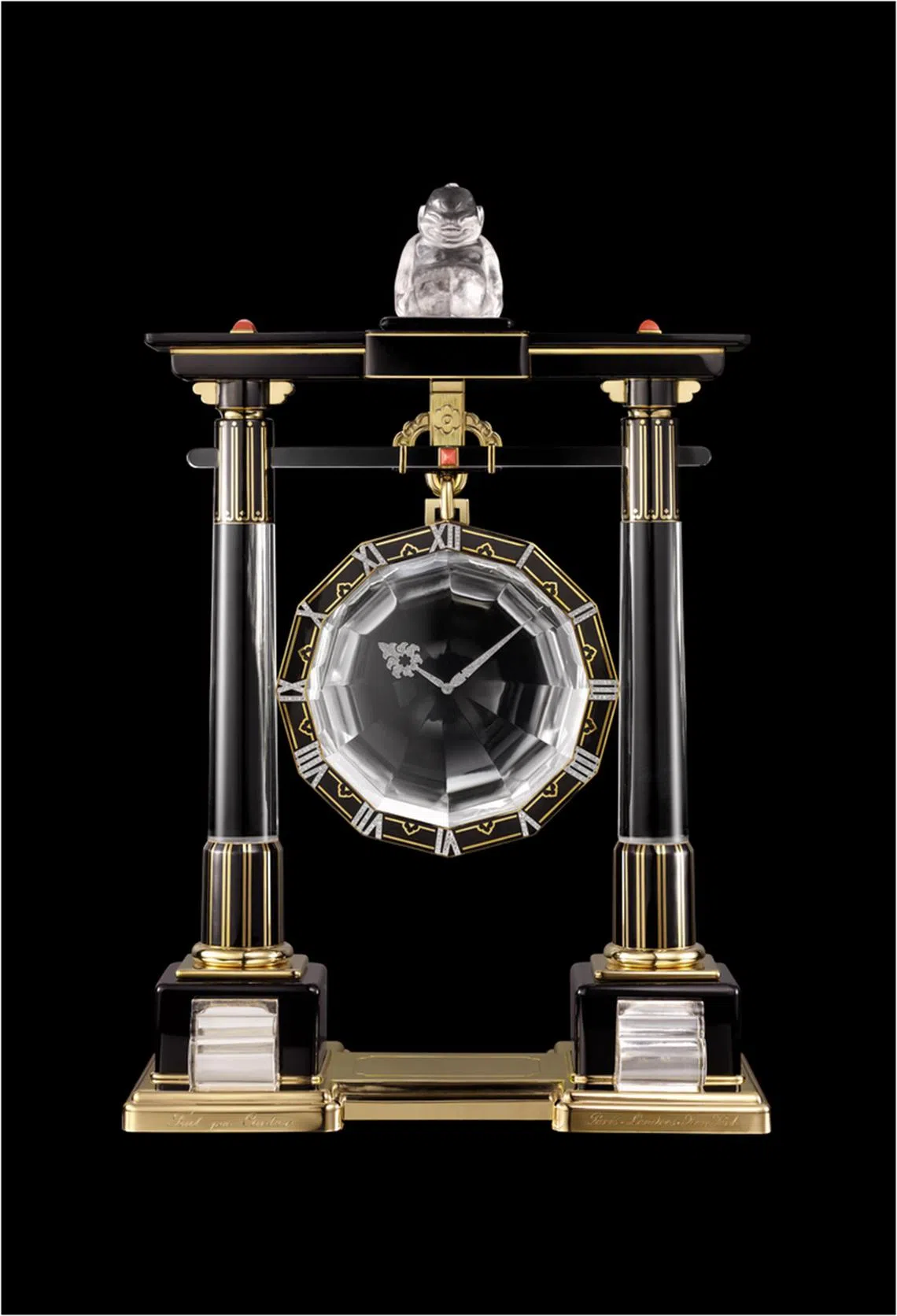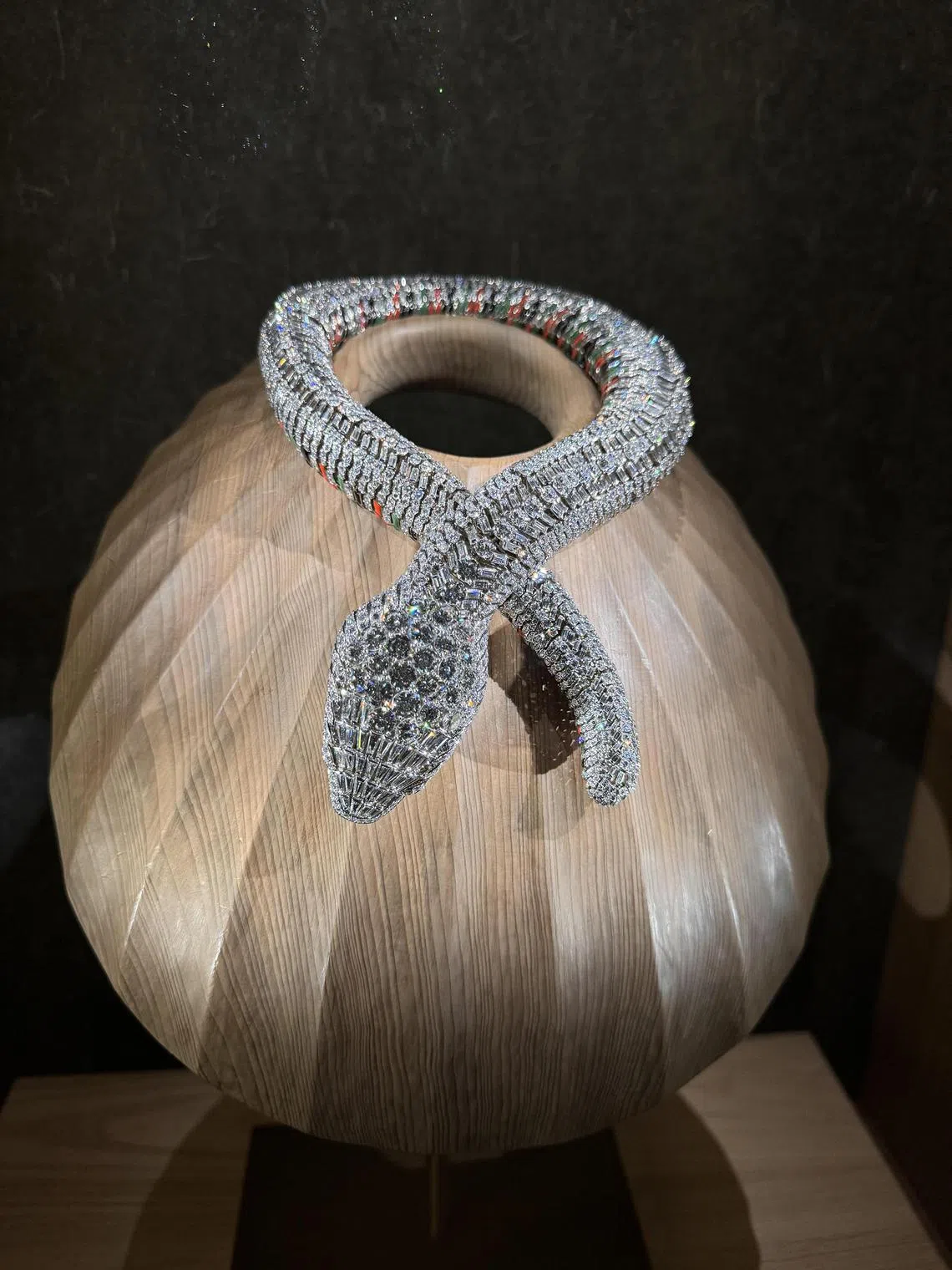Tying the knot: Celebrating Cartier and Japan’s 50-year love affair at Tokyo National Museum
Sign up now: Get ST's newsletters delivered to your inbox

The exhibition showcases more than 170 objects: emblematic and remarkable Maison Cartier creations, archival documents, and personal accounts.
PHOTO: CARTIER
Follow topic:
TOKYO – If you are passionate about fine jewellery, Japanese art or just love beautiful things, do not miss a stunning exhibition at the Tokyo National Museum in Ueno this summer.
Musubi – Half Century Of Cartier In Japan And Beyond: An Everlasting Dialogue Of Beauty And Art is a collaboration between the French luxury house and Japan’s oldest and largest museum. The concept of “musubi” originates from Japanese mythology, symbolising birth and creation. The word also means knots and tying, and the showcase explores how Cartier and Japan have inspired and influenced each other over the decades.
The impressive array of artworks and artefacts on show includes 120 pieces from the Cartier Collection and private loans; over 50 pieces from the Cartier Archives; and more than 150 artworks, including two commissioned wall paintings.
The exhibition, which opened on June 12 and ends on July 28, unfolds in two parallel narratives across the symmetrical wings of the Hyokeikan. The high-domed building, part of the Tokyo National Museum, was designed as Japan’s first dedicated art museum by court architect Katayama Tokuma and completed in 1908.
On one side, Cartier And Japan: A Tribute To Art And Beauty highlights the profound impact of Japanese aesthetics on Cartier’s designs through more than 170 objects – from emblematic Maison Cartier creations to archival documents and personal accounts.
The journey begins with the late Cartier founder Louis Cartier, who, despite never visiting Japan, amassed a collection of Japanese objects and books that inspired his designers. This collection led to the creation of iconic pieces, such as a 1907 Japanese knot brooch fashioned from platinum, gold, diamonds and rubies; and a Portique mystery clock – made from gold, platinum, rock crystal, diamonds and galalith cabochons – resembling a Shinto temple.

A 1923 large Portique mystery clock fashioned from gold, platinum, rock crystal, diamonds and galalith cabochons.
PHOTO: CARTIER
Visitors will be enchanted by how Cartier transforms nature motifs such as plum and cherry blossoms into stunning jewellery featuring rubies, emeralds, diamonds and chalcedony.
The Japanese influence is also reflected in the choice of materials and artisanal techniques, such as lacquer and wickerwork, which have been integral to Cartier’s creations. Particularly striking are the katagami motifs, the intricate art of creating paper stencils for dyeing fabrics.
The beauty of the Cartier creations on display is matched by a mesmerising byobu, or Japanese folding screen, titled Wisteria Of Kasuga Shrine, by architect and photographer Hiroshi Sugimoto.
This section also spotlights major milestones, such as the opening of Cartier’s first Tokyo boutique in Harajuku in 1974 and significant exhibitions in Japan that have showcased Cartier’s exceptional pieces.
Do not miss the jaw-dropping 1968 snake necklace, crafted from platinum, white gold, yellow gold, diamonds, emeralds and coloured enamel. This breathtaking piece, custom-made for the late Mexican actress Maria Felix, was displayed at the National Art Centre in Tokyo as part of the Cartier Crystallisation Of Time exhibition in 2019.

A 1968 snake necklace made from platinium, white gold, yellow gold, diamonds, emeralds and coloured enamel made for the late Mexican actress Maria Felix.
ST PHOTO: WONG KIM HOH
Other headturners include a series of works evoking Cartier’s iconic Trinity ring by contemporary artist Katsuhiko Hibino in 1997, artworks celebrating 100 years of the Tank watch in 2017 by Japanese singer and celebrity Shingo Katori, and the 2018 konbini (convenience store) pop-up in Omotesando featuring works by Argentine artist Leandro Erlich.
The other wing of the Hyokeikan, meanwhile, is devoted to Fondation Cartier Pour L’art Contemporain And Japanese Artists: A Never-Ending Conversation. This section explores the artistic collaborations fostered by the Fondation Cartier, set up to raise awareness of contemporary art.
Since its inception in 1984, the Fondation Cartier has worked with many Japanese artists, giving them the freedom to explore new creative avenues and showcasing their works to European audiences. The artists come from various fields and disciplines – from painting and photography to architecture, design and video.
Fashion designer Issey Miyake once said in an interview: “I was reborn here because the Fondation Cartier offered me the possibility to be different, and the freedom to think.”

A 2013 Cartier wristwatch with turtle motif featuring diamonds, emeralds and enamel.
PHOTO: CARTIER
In 1998, he worked with the Fondation to stage his Making Things exhibition in Paris, which explores how imagination and technology can renew and reinvent fashion. An installation from that exhibition is a highlight in the Musubi showcase.
Another riveting narrative in this section involves the artistic talents of Takeshi Kitano, better known as a film-maker, comedian and actor. On show are several of his paintings, as well as the animal vases he created for Beat Takeshi Kitano, Gosse De Peintre, a site-specific exhibition which explored the joys of childhood, held at the Fondation Cartier in Paris in 2010. Look out for the whimsical valise containing the painter tools he designed, which was crafted by Cartier artisans.

A whimsical valise containing painter tools designed by film-maker Takeshi Kitano.
ST PHOTO: WONG KIM HOH
Specially commissioned by Cartier and installed in the heart of the Hyokeikan, New York-based Japanese artist Sho Shibuya’s Fifty Sky Views Of Japan provides a poetic conclusion to the exhibition.
Inspired by the 53 Stations Of The Tokaido, a series of woodcut prints by famous ukiyo-e artist Utagawa Hiroshige, he travelled across Japan, painting a view of the sky each day on the front page of a local newspaper. Like Hiroshige, he began his journey in Nihonbashi.
He says simply: “If you want to understand a country, you need to be there.”

Japanese artist Sho Shibuya travelled across the country to create a series of 50 paintings titled Fifty Sky Views Of Japan.
PHOTO: CARTIER
Curator Helene Kelmachter: Japanese art exudes a joy of creation
Ms Helene Kelmachter cuts a striking figure at the Tokyo National Museum, her sculptural burgundy Issey Miyake dress highlighting her auburn hair combed into an elegant chignon.
The Frenchwoman is the curator for Musubi – Half Century Of Cartier In Japan And Beyond: An Everlasting Dialogue Of Beauty And Art. On show at the museum’s Hyokeikan building in Ueno until July 28, the exhibition depicts the deep cultural connections between the French luxury house and Japanese artistry.
Weaving together the intricate relationship between Cartier and Japan was both an exhilarating and enriching experience, says Ms Kelmachter. When she was first approached to curate this exhibition, she was instantly captivated by the depth of the story.
“The idea was to dive into the narrative,” she says, “and the more I learnt, the more I discovered the countless stories to tell.”
It quickly became apparent that it was impossible to encapsulate this rich history in a single narrative. Instead, the exhibition blossomed into two parallel yet interconnected chapters – the relationship between Cartier and Japan, and the Fondation Cartier’s work with contemporary Japanese artists.
The exhibition took more than a year to finalise, with Ms Kelmachter dedicating herself wholly to the project since October 2023.
“It was challenging, especially considering the unique architecture of the Hyokeikan building,” she notes. The historical building’s restrictions on hanging artwork on the walls pushed the curator and her team to creatively utilise the space, transforming the challenge into an innovative display method.

Showcased at the exhibition are 120 works by artists who have worked with Fondation Cartier, including designer Issey Miyake, film-maker and artist Takeshi Kitano and photographer Nobuyoshi Araki.
PHOTO: CARTIER
They decided to “play with the architecture”, using not only the eight exhibition rooms, but also the connecting spaces to create a complete journey for visitors.
One of the most intriguing aspects of this exhibition is its dual narrative approach.
“We approached the two chapters simultaneously,” Ms Kelmachter says. The symmetrical architecture of the Hyokeikan, with its four rooms on each side connected by an atrium, perfectly facilitated this dual storytelling.
The first chapter delves into Maison Cartier’s 150-year relationship with Japan, highlighting how Japanese art influenced Cartier’s design ethos. The second chapter showcases the Fondation Cartier’s collaborations with Japanese artists, emphasising a continuous, ongoing conversation.
“The heritage part was a new challenge for me,” she says, “but working with Pierre Rainero (Cartier’s image, style and patrimony director) and the heritage team made it a deeply enriching experience. It was about showcasing how beauty and creation have always been at the heart of Cartier.”

Exhibition curator Helene Kelmachter took more than a year to put the exhibition together. She is seen here posing in front of works by film-maker Takeshi Kitano (left) and graphic designer Tadanori Yokoo.
ST PHOTO: WONG KIM HOH
The section featuring Fondation Cartier’s collaborations with Japanese artists was easier, thanks to her 15-year tenure at the Fondation and her familiarity with the Japanese art scene, which she says is characterised by “freedom of experimenting” and a “joy of creation”.
She describes working on Miyake’s Making Things exhibition, held in Paris in 1998, as a pivotal moment in her career.
“It was magical to work closely with a visionary like Miyake, who always pushed the boundaries of innovation,” she says.
Selecting exhibits and artworks for the exhibition was no easy feat.
“You always want to tell everything,” she says.
The key, she adds, was to create a meaningful journey that would resonate with visitors. Despite the breadth of the exhibition, Ms Kelmachter finds it impossible to choose a favourite section.
“Every story is so unique,” she says.
• Musubi – Half Century Of Cartier In Japan And Beyond: An Everlasting Dialogue Of Beauty And Art is held at the Hyokeikan until July 28. Go to str.sg/fWpt


